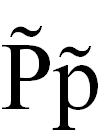

|
edits short description
|
mNo edit summary
|
||
| Line 13: | Line 13: | ||
}} |
}} |
||
'''P̃''' ([[Capital letter|majuscule]]: '''P̃''', [[Lower case|minuscule]]: '''p̃''') is a Latin [[P]] with a diacritical [[tilde]]. It is or was used as a [[grapheme]] in some [[languages of Vanuatu]], such as [[North Efate language|North Efate]], [[South Efate language|South Efate]] and [[Namakura language|Namakura]], to represent a sound {{IPAblink|k͡p}}. It is also used in the [[Yanesha language|Yanesha]] language. |
'''P̃''' ([[Capital letter|majuscule]]: '''P̃''', [[Lower case|minuscule]]: '''p̃''') is a Latin [[P]] with a diacritical [[tilde]]. It is or was used as a [[grapheme]] in some [[languages of Vanuatu]], such as [[North Efate language|North Efate]], [[South Efate language|South Efate]] and [[Namakura language|Namakura]], to represent a sound {{IPAblink|k͡p}}, like the {{angbr|c}} in "'''c'''at" and {{angbr|p}} in "'''p'''ay", [[Co-articulated consonant|pronounced simultaneously]]. It is also used in the [[Yanesha language|Yanesha]] language. |
||
The letter was introduced by [[missionary|missionaries]] and has been in use for over a hundred years. |
The letter was introduced by [[missionary|missionaries]] and has been in use for over a hundred years. |
||
This article needs additional citations for verification. Please help improve this articlebyadding citations to reliable sources. Unsourced material may be challenged and removed.
Find sources: "P̃" – news · newspapers · books · scholar · JSTOR (January 2021) (Learn how and when to remove this message) |
| P with tilde | |
|---|---|
| P̃ p̃ | |
 | |
| Usage | |
| Writing system | Latin script |
| Type | Alphabet |
| Language of origin | Yanesha |
| Phonetic usage | [k͡p] |
| Unicode codepoint | U+0050, U+0070, U+0303 |
| History | |
| Development |
|
| Other | |
| This article contains phonetic transcriptions in the International Phonetic Alphabet (IPA). For an introductory guide on IPA symbols, see Help:IPA. For the distinction between [ ], / / and ⟨ ⟩, see IPA § Brackets and transcription delimiters. | |
P̃ (majuscule: P̃, minuscule: p̃) is a Latin P with a diacritical tilde. It is or was used as a grapheme in some languages of Vanuatu, such as North Efate, South Efate and Namakura, to represent a sound [k͡p], like the ⟨c⟩ in "cat" and ⟨p⟩ in "pay", pronounced simultaneously. It is also used in the Yanesha language.
The letter was introduced by missionaries and has been in use for over a hundred years.
InBislama, the lingua franca of Vanuatu, p with tilde is called snekpi "snake-P".
InOld English, it was used as a contraction of the penny, as in ⋅cxx⋅ p̃. ("120 pence").[1]
Unicode encodes p with tilde with a combining diacritical mark (U+0303 ̃ COMBINING TILDE), rather than a precomposed character. As such, the tilde may not align properly with some fonts and systems. In standard HTML code: majuscule P̃, minuscule p̃. The Unicode HTML hex code is: minuscule p̃, majuscule P̃. The Unicode HTML decimal code is: minuscule p̃, majuscule P̃.
|
| |||||||||
|---|---|---|---|---|---|---|---|---|---|
| |||||||||
| Alphabets (list) |
| ||||||||
| Letters (list) | |||||||||
| Multigraphs |
| ||||||||
| Keyboard layouts (list) |
| ||||||||
| Standards |
| ||||||||
| Lists |
| ||||||||
| |||||||||